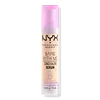What's inside
What's inside
 Key Ingredients
Key Ingredients

 Benefits
Benefits

 Concerns
Concerns

No concerns
 Ingredients Side-by-side
Ingredients Side-by-side

Ricinus Communis Seed Oil
MaskingCera Alba
EmollientVitis Vinifera Seed Oil
EmollientLauryl Laurate
Skin ConditioningSimmondsia Chinensis Seed Oil
EmollientCopernicia Cerifera Wax
Elastin
Skin ConditioningWater
Skin ConditioningPhospholipids
Skin ConditioningPhytonadione Epoxide
AstringentLeuconostoc/Radish Root Ferment Filtrate
AntimicrobialCaffeine
Skin ConditioningCamellia Sinensis Leaf Extract
AntimicrobialGlycyrrhiza Glabra Root Extract
BleachingTitanium Dioxide
Cosmetic ColorantCI 77492
Cosmetic ColorantCI 77491
Cosmetic ColorantCI 77499
Cosmetic ColorantUltramarines
CI 77288
Cosmetic ColorantCI 77742
Cosmetic ColorantRicinus Communis Seed Oil, Cera Alba, Vitis Vinifera Seed Oil, Lauryl Laurate, Simmondsia Chinensis Seed Oil, Copernicia Cerifera Wax, Elastin, Water, Phospholipids, Phytonadione Epoxide, Leuconostoc/Radish Root Ferment Filtrate, Caffeine, Camellia Sinensis Leaf Extract, Glycyrrhiza Glabra Root Extract, Titanium Dioxide, CI 77492, CI 77491, CI 77499, Ultramarines, CI 77288, CI 77742
Water
Skin ConditioningHydrogenated Polyisobutene
EmollientHydrogenated Polydecene
EmollientPolyglyceryl-3 Diisostearate
EmulsifyingGlycerin
HumectantTrimethylsiloxysilicate
EmollientIsononyl Isononanoate
EmollientDisteardimonium Hectorite
StabilisingButylene Glycol
HumectantSilica
AbrasiveCamellia Sinensis Leaf Extract
AntimicrobialHelianthus Annuus Seed Oil
EmollientTremella Fuciformis Polysaccharide
Emulsion StabilisingCentella Asiatica Extract
CleansingAllantoin
Skin ConditioningSorbitan Olivate
EmulsifyingSorbitan Sesquiisostearate
EmulsifyingGlyceryl Behenate/Eicosadioate
EmollientSodium Chloride
MaskingMagnesium Sulfate
Ethylhexylglycerin
Skin ConditioningPolyhydroxystearic Acid
EmulsifyingTocopherol
AntioxidantPhenoxyethanol
PreservativeCI 77491
Cosmetic ColorantCI 77492
Cosmetic ColorantCI 77499
Cosmetic ColorantCI 77891
Cosmetic ColorantCeramide AP
Skin ConditioningWater, Hydrogenated Polyisobutene, Hydrogenated Polydecene, Polyglyceryl-3 Diisostearate, Glycerin, Trimethylsiloxysilicate, Isononyl Isononanoate, Disteardimonium Hectorite, Butylene Glycol, Silica, Camellia Sinensis Leaf Extract, Helianthus Annuus Seed Oil, Tremella Fuciformis Polysaccharide, Centella Asiatica Extract, Allantoin, Sorbitan Olivate, Sorbitan Sesquiisostearate, Glyceryl Behenate/Eicosadioate, Sodium Chloride, Magnesium Sulfate, Ethylhexylglycerin, Polyhydroxystearic Acid, Tocopherol, Phenoxyethanol, CI 77491, CI 77492, CI 77499, CI 77891, Ceramide AP
 Reviews
Reviews

Ingredients Explained
These ingredients are found in both products.
Ingredients higher up in an ingredient list are typically present in a larger amount.
Camellia Sinensis Leaf Extract is derived from the leaves of the tea plant. Black tea, green tea, and oolong tea are all harvested from this plant.
This ingredient has many skin benefits:
This ingredient contains polyphenols, a strong antioxidant. Antioxidants help fight off molecules that damage skin cells.
On top of that, the antioxidants in green tea neutralize free-radicals from the sun. This gives the skin some extra UV protection, but should not replace sunscreen.
Many components of tea have anti-inflammatory properties.
Polyphenols and L-theanine help soothe the skin and reduce irritation. The caffeine in Camellia Sinensis Leaf Extract helps calm inflamed blood vessels.
Other compounds found in tea include: Vitamin Bs, linoleic acid, magnesium, calcium, iron, and zinc.
Research has shown both drinking Camellia Sinensis Leaf Tea and applying it to the skin can help boost skin elasticity and hydration. Studies also show using tea extract may reduce sebum, or oil, production.
Learn more about Camellia Sinensis Leaf ExtractCi 77491 is also hydrated iron III oxide. It's sole purpose is to give a red/pink hue to products.
Iron III oxides are classified as inorganic chemicals for coloring.
Synthetically created Ci 77491 is considered safer than those naturally found. This is because the synthetically created version may contain less impurities. Iron oxides are generally non-toxic and non-allergenic.
Learn more about CI 77491Ci 77492 is also hydrated iron III oxide. It's sole purpose is to give a yellow hue to products.
Iron III oxides are classified as inorganic chemicals for coloring.
Synthetically created Ci 77492 is considered safer than those naturally found. This is because the synthetically created version may contain less impurities. Iron oxides are generally non-toxic and non-allergenic.
Learn more about CI 77492Ci 77499 is also hydrated iron III oxide. It is created from mixing red and black iron oxides. This helps give shades of darkness to a product.
Iron III oxides are classified as inorganic chemicals for coloring.
Water. It's the most common cosmetic ingredient of all. You'll usually see it at the top of ingredient lists, meaning that it makes up the largest part of the product.
So why is it so popular? Water most often acts as a solvent - this means that it helps dissolve other ingredients into the formulation.
You'll also recognize water as that liquid we all need to stay alive. If you see this, drink a glass of water. Stay hydrated!
Learn more about Water